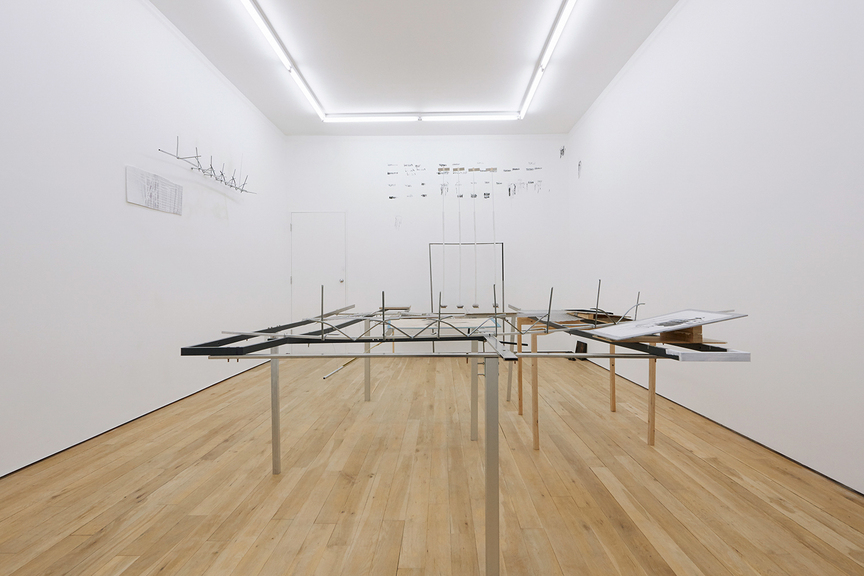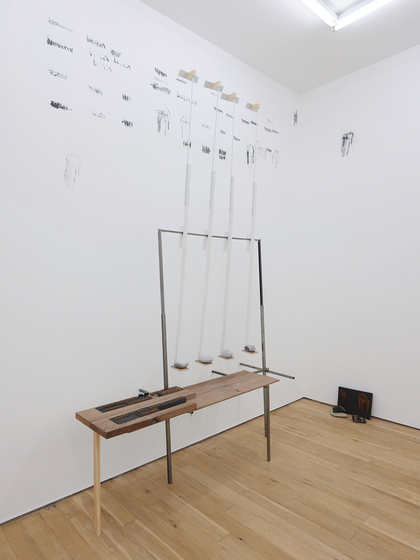-
From Current Issue
-
- Editor’s Letter Fire in the Heart
- Reviews I Gusti Ayu Kadek Murniasih
- Reviews 11th Seoul Mediacity Biennale: “One Escape at a Time”
- Dispatch Networked China
- One on One Monira Al Qadiri on Yukio Mishima
- Essays The rise of independent art spaces in pandemic-era Shanghai
- Features Tuan Andrew Nguyen
- Table of Contents
- Web Exclusives
- Archive
- Subscribe

R
E
V N
E
X
T
Jewyo Rhii’s exhibition “The Day 3, Walls and Barbed” at Amanda Wilkinson gallery—a 24-square-meter exhibition space located in a walk-up between adult stores in one of the seedier parts of London’s Soho—is a response to a response. The show’s story began with a previous project titled “Night Studio,” for which the artist opened her home studio in Seoul to the public four times during 2010 and ’11, and created over 20 works as a reflection on her moving to a new neighborhood and the experience of breaking down boundaries. The resulting artworks were later used in a solo exhibition at the Van Abbemuseum in Eindhoven in 2013 called “Walls to Talk to,” for which Rhii asked the Dutch art historian Irene Veenstra to create a response that eventually took the form of a journal called Buiten de Comfort Zone (Outside the Comfort Zone) (2013). The title of “The Day 3, Walls and Barbed” is Rhii’s artistic response to Veenstra’s third entry, where Veenstra comments on work that invokes borders, boundaries and walls in the presentation at Van Abbemuseum.
The piece at the center of both the exhibition and the small gallery that housed it was Drawing Table –Outside The Comfort Zone, Day 3– (2016). Ostensibly an extension of Rhii’s interest in walls (as described by Veenstra), this topless table constructed from metal bars bolted together and interspersed with mesh and crude drawings is formally chaotic and, if it does harbor any conceptual depth, this is not forthcoming. It is possible that the piece would have benefitted from a larger space—a generous appraisal might attribute its cluttered presentation to a reflection on the unstable domestic states that inspired Rhii to begin with, as in the difficulties of settling and organizing one’s space when leading the kind of peripatetic life for which the artist is known—but even then the conceptual scaffolding beneath this aluminium and steel framework could not escape an air of near-solipsism. As in echo chambers and gene pools, when iterations become too insular, information is lost.
The most effective creations here, then, were those that are more engaged with the world beyond the work, even if that world only extends as far as the walls of a modestly sized gallery. In Stone Typing Machine (2017), for instance, a wooden frame supports four pivoted rods counterweighted with round stones and bearing stamps. With each stamp holding a word and loaded with ink, these rods had been swung at the gallery’s white walls and left prints of varying clarity, introducing hints of additional information such as velocity of impact, and the motion of the body that controlled the machine, to the printed texts. The words themselves—“walls,” “bars,” “poles,” “answered”—appear once again not to reference anything external to the work. But the limited number of these words, their physical expression on the wall, the implication of force, and that they have been made by a device that depends on human action, create an uneasy feeling of restricted communication that is juxtaposed with the toy-like appearance of the machine.
The concern for mark-making here was the most provocative and identifiable theme in “Day 3,” and yet was explored with relative subtlety. Incomplete grids and occasionally text appear in works such as Fence Drawing (2017)—in which foam boards bearing vertical and horizontal lines, a kind of large, homemade barbed wire, and illegibly faint spray paint occupied a wall of the gallery—or Day 3 Ice Sculpture (2017), where two blocks of ice impaled on a pair of metal arches melt above an aluminum table bearing further grid-like lines in black. But, like much of the exhibition, they were not readable, and did not compensate for this with formal appeal.
There were many other small pieces—several untitled grids painted or printed on wood and metal panels—and some works that also reference processes of mark-making by, for instance, bearing paint transferred from projectiles, as on the wooden panel entitled Thrown Stones (2017). Whether any of this could be deemed an enquiry, however, and whether it went beyond showing a thing and actually asked what it was about, was debatable.
Ned Carter Miles is the London desk editor of ArtAsiaPacific.
Jewyo Rhii’s “The Day 3, Walls and Barbed” is on view at Amanda Wilkinson gallery, London, until January 21, 2018.
To read more of ArtAsiaPacific’s articles, visit our Digital Library.









